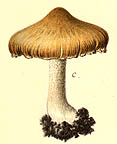 Key to Gilled Mushrooms Key
Key to Gilled Mushrooms KeyThis is a key to gilled mushrooms, that is, mushrooms having a definite cap with a fertile surface consisting of gills. The fruiting body usually also has a stem, although that may be lateral or absent (usually, then, the mushroom is growing from wood). You can use this key to identify mushrooms that you find.
 Agaricales Order
Agaricales OrderFruiting body containing fibers (usually in the stalk)
 Brown, Olive, Orange or Tan Spored Suborder
Brown, Olive, Orange or Tan Spored SuborderGills not free
Spore print tan, orange, deep ochre, yellowish olive, olive brown, rusty or cinnamon brown or deep brown
Ring usually either absent or not membranous
 Lignicolous Brown Spored Family
Lignicolous Brown Spored FamilyGrowing on wood
 Medium To Big Lignicolous Brown Spored Subfamily
Medium To Big Lignicolous Brown Spored SubfamilyCap usually more than 2" across, and sometimes up to 8; usually tan, yellow, or pumpkin-colored
Paxillus Genus Fries

Diagnosis
Microscropic Characters
Comments
Paxillus is actually a "missing link" taxon (except that it's not missing!) between boletes and gilled mushrooms. The gills cross one another and become sorta poroid near the stem; and the gill layer can usually be cleanly peeled from the cap, just like the tubes of a bolete
Narrow down your identification:
 Paxillus atrotomentosus
Paxillus atrotomentosusCap up to 6" across; brown
Stalk with a velvety coating of blackish-brown hairs
Paxillus corrugatusCap up to 2" across; brownish, often with reddish-brown patches
Stalk absent
Gills bright orange or orange yellow
On coniferous wood, especially hemlock and pine
 Paxillus involutus
Paxillus involutusCap up to 6" across; light brown; viscid, at least at the disk, when moist; often slightly velvety
Fruiting body staining reddish brown when cut or bruised
Usually with birch, oak or pine
Paxillus panuoidesCap up to 5" across; dingy olive to dingy maroon; no reddish-brown patches
Stalk absent
Gills yellow
On coniferous wood






 Key to Gilled Mushrooms Key
Key to Gilled Mushrooms Key Agaricales Order
Agaricales Order Brown, Olive, Orange or Tan Spored Suborder
Brown, Olive, Orange or Tan Spored Suborder Medium To Big Lignicolous Brown Spored Subfamily
Medium To Big Lignicolous Brown Spored Subfamily
 Paxillus atrotomentosus
Paxillus atrotomentosus Paxillus involutus
Paxillus involutus




